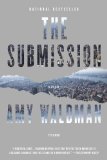Summary | Excerpt | Reading Guide | Reviews | Beyond the Book | Read-Alikes | Genres & Themes | Author Bio

A Novel
by Amy WaldmanThis article relates to The Submission
 The search for the World Trade Center Memorial design, which is now being built where the Twin Towers once stood, began in 2003. While honoring those who lost their lives on September 11, 2001, the memorial also pays tribute to the seven people killed and thousands injured in the WTC attack on February 26, 1993. Memorializing these 3,000+ people, the national monument incorporates the victims' names at the very center of its structure.
The search for the World Trade Center Memorial design, which is now being built where the Twin Towers once stood, began in 2003. While honoring those who lost their lives on September 11, 2001, the memorial also pays tribute to the seven people killed and thousands injured in the WTC attack on February 26, 1993. Memorializing these 3,000+ people, the national monument incorporates the victims' names at the very center of its structure.
In total, 5,201 designs were received, and 62 countries were represented by the submissions. The selection committee - a jury of thirteen people - included architects (for example, Maya Lin, the designer of the Vietnam Veteran's Memorial in Washington, DC), artists, political representatives, curators, and Paula Grant Barry, a woman whose husband was killed in the attacks and who acted as a representative for victims' families. After some deliberation, they announced their decision in January 2004; the winning design, "Reflecting Absence", was created by architect Michael Arad, and landscape architect Peter Walker.
In their announcement, the jury issued the following statement (excerpted):
Of all the designs submitted, we have found that "Reflecting Absence"... fulfills most eloquently the daunting but absolutely necessary demands of this memorial. In its powerful, yet simple articulation of the footprints of the Twin Towers, "Reflecting Absence" has made the voids left by the destruction the primary symbols of our loss. By allowing absence to speak for itself, the designers have made the power of these empty footprints the memorial. At its core, this memorial is anchored deeply in the actual events it commemorates - connecting us to the towers' destruction, and more important, to all the lives lost on that day....
While the footprints remain empty, the surrounding plaza's design has evolved to include beautiful groves of trees, traditional symbols of life and rebirth. These trees, like the memories of the victims, demand care and nurturing; in their own annual cycles, they serve as living representations of both death and renewal. The result is a memorial that expresses both the incalculable loss suffered and the consoling regeneration of hope and life.
The selection of Arad and Walker's "Reflecting Absence" came with its own controversy. Among other complaints, the design was criticized for being too stark and for not making more of a distinction between civilian victims and rescuers who died in the line of duty. With this and other concerns in mind, Arad and Walker made "significant changes" to their original plans.
WTC Photo credit: Department of Defense
Filed under Cultural Curiosities
![]() This "beyond the book article" relates to The Submission. It originally ran in October 2011 and has been updated for the
March 2012 paperback edition.
Go to magazine.
This "beyond the book article" relates to The Submission. It originally ran in October 2011 and has been updated for the
March 2012 paperback edition.
Go to magazine.
Your guide toexceptional books
BookBrowse seeks out and recommends the best in contemporary fiction and nonfiction—books that not only engage and entertain but also deepen our understanding of ourselves and the world around us.